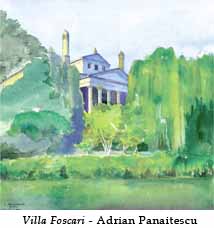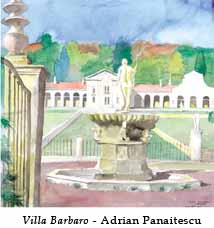 |
 |
|
|
|
2008
Veneto-Venice Music, Performers Summary of Festival Venues for Events Accommodations for |
Festival Center and Accommodations for Performers and StaffThe Festival week events will be centered at Palladio’s Villa Saraceno at Finale di Agugliaro, located outside of Venice, where the performers and staff will be in residence for the week.
Palladio’s Villa Saraceno was specifically chosen as the site for the Festival in Honor of Palladio at 500. The Villa Saraceno represents an example of the “perfect house” in the words of Professor Witold Rybczynski, from his book, The Perfect House: A Journey with the Renaissance Master, Andrea Palladio(Scribner, New York 2002). Palladio’s objective, expressed in his Quattro libri dell’architettura, was to build “in such a way and with such proportions that together all the parts convey to the eyes of onlookers a sweet harmony.” Professor Rybczynski summarizes Palladio’s secret: “He pleases the mind as well as the eye. His sturdy houses, rooted in their sites, radiate order and balance, which makes them both of this world and otherwordly. Although they take us out of ourselves, they never let us forget who and what we are. They really are perfect.” The British Landmark Trust has provided some background on the Villa Saraceno. “Part of the importance of the Villa Saraceno lies in the fact that it was one of Palladio’s early commissions. Begun between 1546 and 1555 for Biagio Saraceno, it belongs to the early group of villas which includes those at Valmarana and Pisani. Villa Rotunda was not commissioned until 1566 and Palladio’s magnificent church in Venice, San Giorgio Maggiore, not until 1570. “The Saraceno family moved to Vicenza from Rome in the late 13th century. They were members of the minor nobility and pursued professional careers in the church, law and medicine. They also built up agricultural estates, improving the land and introducing new crops and methods. All that was realized of Palladio’s noble concept – a beautifully proportioned house clasped by the colonnaded wings of a Roman courtyard – was the principal house itself. . . .
“Parte dell’importanza di Villa Saraceno risiede nel fatto che fu una delle prime opera commissionata al Palladio. Iniziata fra il 1546 e il 1555 per Biagio Saraceno, appartiene al primo gruppo di ville palladiane, che include la Valmarana e la Pisani. La Ville Rotunda fu commissionata dope il 1566, come pure la magnifica chiesa del Palladio a Venezia, San Giorgio Maggiore. “La famiglia Saraceno si fransferì a Vicenza da Roma nel tardo XIII secolo. Faceva parte della nobilità minore e I suoi membri perseguirono carriere professionali nella chiesa, nella giurisprudenza e nella medicina. Construirono anche tenute agricole, migliorando la terra ed introducendo nuove colture e medtodi. Tutto quello che fu relizzato del grandioso progetto di Palladio per la construzione della villa padronale – una casa di splendide proporzioni, avvolta dale colonne di dun portico romano – fu il corpo padronale. . . .
|


